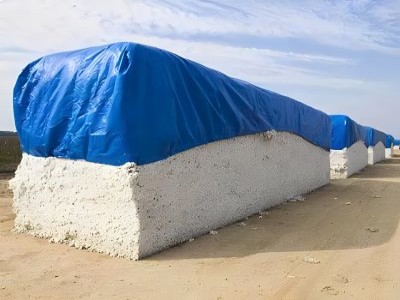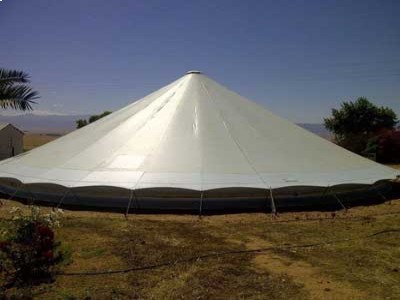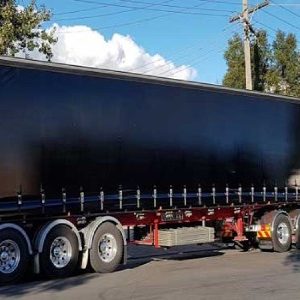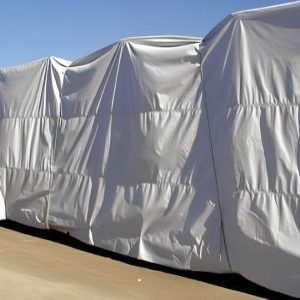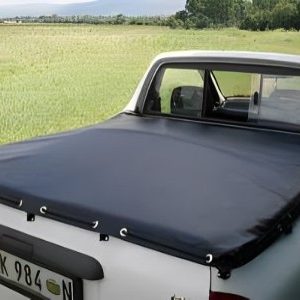Types of Agricultural Tarpaulins
1. Heavy-Duty Poly Tarps: Poly tarps are widely used in agriculture due to their affordability and versatility. These tarps are made from polyethylene, offering excellent waterproofing and UV resistance. They are ideal for covering hay, silage, and machinery.
2. Canvas Tarps: Canvas tarpaulins are durable and breathable, making them perfect for agricultural applications that require airflow. They are commonly used to cover crops, livestock shelters, and equipment.
3. Vinyl Tarps: Vinyl tarps are known for their strength and resistance to chemicals, oil, and mildew. These tarps are ideal for long-term agricultural applications such as greenhouse coverings and grain storage protection.
4. Mesh Tarps: Mesh tarpaulins provide partial shade and ventilation, making them suitable for shading plants, livestock pens, and nursery applications. They are also used for erosion control in farmlands.
5. Silage Covers: Silage tarps help in fermenting and preserving livestock feed. They are designed to block oxygen from entering silage pits, ensuring proper fermentation and reducing spoilage.
Benefits of Using Agricultural Tarpaulins
1. Protection Against Weather Conditions: Tarpaulins shield crops, equipment, and livestock from rain, snow, wind, and excessive sunlight. Waterproof and UV-resistant tarps prevent damage caused by unpredictable weather.
2. Cost-Effective Farm Management: Instead of investing in permanent structures, farmers can use tarps to cover temporary storage areas, reducing costs while maintaining protection.
3. Increased Crop Yield and Livestock Health: By covering crops with appropriate tarps, farmers can prevent damage from excessive moisture and pests, leading to higher yields. Livestock also benefits from properly shaded and covered shelters.
4. Versatile Applications: Agricultural tarpaulins are used for multiple purposes, including ground cover, fencing, greenhouse protection, and transportation covers.
How to Choose the Right Agricultural Tarpaulin
1. Consider the Material: The type of material depends on your needs. For waterproof and UV protection, poly or vinyl tarps work best. For breathability, canvas tarps are ideal.
2. Check the GSM (Grams per Square Meter): A higher GSM indicates a thicker and more durable tarp. Heavy-duty tarps (200-400 GSM) are suitable for long-term agricultural use.
3. Look for Reinforced Edges: Tarps with reinforced edges and rust-proof grommets last longer and provide better resistance against strong winds.
4. UV and Waterproof Protection: Ensure that the tarp has UV treatment and waterproof coatings to withstand outdoor exposure for extended periods.
5. Size and Coverage Area: Choose the right size based on your intended use. A larger tarp provides better coverage, while smaller tarps work well for localized applications.
Best Uses of Agricultural Tarpaulins
- Hay and grain storage – Protects from moisture and pests.
- Livestock shelters – Provides shade and shelter from harsh weather.
- Greenhouse coverings – Regulates temperature and humidity.
- Mulching and ground cover – Prevents weeds and retains soil moisture.
- Equipment and vehicle covers – Protects from dust, rain, and UV damage.
- Pond liners and irrigation protection – Helps in water conservation.
Where to Buy Agricultural Tarpaulins on Sale?
Finding high-quality Agricultural Tarps at competitive prices is easier than ever. Many online retailers and local farm supply stores offer discounts and bulk deals on tarpaulins. When purchasing, consider factors such as warranty, material quality, and customer reviews to ensure a wise investment.
Frequently Asked Questions (FAQs)
1. What is the best type of tarp for agricultural use?
The best tarp depends on the intended use. Poly tarps are great for general protection, while vinyl tarps are ideal for long-term use. Canvas tarps provide breathability, and mesh tarps are suitable for shade applications.
2. How long do agricultural tarpaulins last?
The lifespan of an agricultural tarp varies based on material and usage. Heavy-duty tarps can last 3-5 years, while lighter ones may need replacement sooner.
3. Are agricultural tarps waterproof?
Yes, most poly and vinyl agricultural tarps are waterproof, preventing moisture damage to crops, hay, and equipment.
4. Can I use a tarp for greenhouse applications?
Yes, transparent or UV-resistant tarps are commonly used as greenhouse covers to control temperature and humidity.
5. How do I secure a tarp against strong winds?
Use heavy-duty grommets and bungee cords or stakes to secure the tarp firmly. Reinforced edges help prevent tearing in windy conditions.


